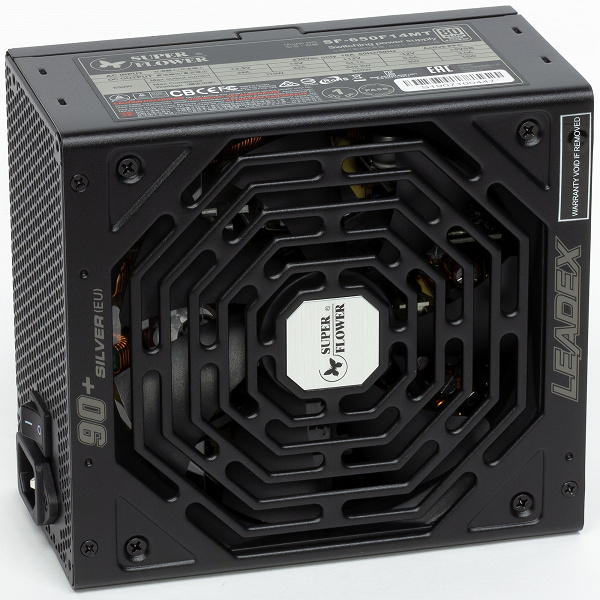
We continue to get acquainted with the products of the Taiwanese company Super Flower. This time, the focus of our attention was on the Super Flower Leadex Silver 650W budget power supply, the cost of which at the time of writing the review was about 6500 rubles. In addition to the 650 W model, the Leadex Silver series, to which our test subject belongs, includes models with a power of 550, 750 and 850 W. All are 80Plus Silver certified for 230V.
The cases of all Super Flower power supplies are very similar in appearance: they are a black elongated parallelepiped with a stamped lattice of the original design, which has a matte finish with a fine texture. The power supply has a switch with which you can select the mode of operation of its cooling system: conventional or hybrid. In the first case, the fan rotates during the operation of the PSU all the time, and in the second it is able to stop sometimes. The switch is located in such a way that after installing the power supply in the system unit, it will be inside the computer case, that is, it will not be very convenient to use it regularly.
The length of the power supply housing is about 165 mm, an additional 15-20 mm is required for the supply of wires, so during installation it is worth counting on an installation size of about 185 mm. For small-sized cases, such models are usually not suitable.
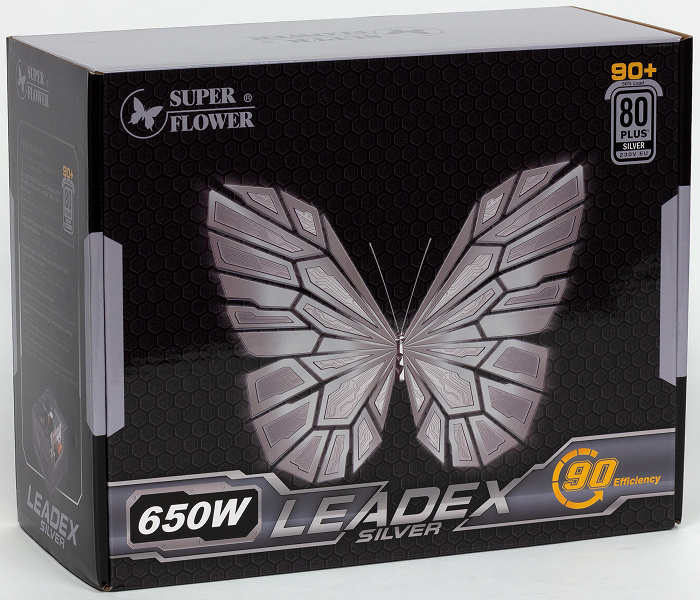
The packaging of the power supply is a cardboard box of sufficient strength with matte printing. The design is dominated by shades of black and gray.
Characteristics
All the necessary parameters are indicated on the power supply case in full, for the bus power + 12VDC the value of 649.2 W is declared. The ratio of +12VDC bus power to full power is 0.9988, which is, of course, an excellent indicator.
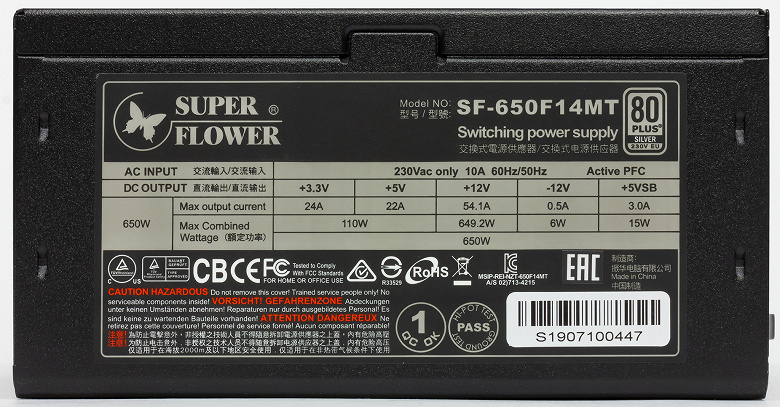
Wires and Connectors
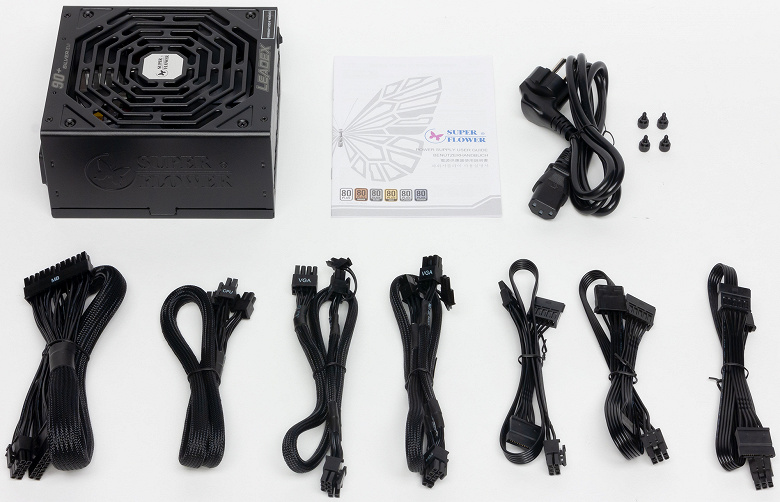
| Connector name | Number of connectors | Notes |
|---|---|---|
| 24 pin Main Power Connector | one | collapsible |
| 4 pin 12V Power Connector | — | |
| 8 pin SSI Processor Connector | one | collapsible |
| 6 pin PCI-E 1.0 VGA Power Connector | — | |
| 8 pin PCI-E 2.0 VGA Power Connector | 4 | on two cords |
| 4 pin Peripheral Connector | 3 | |
| 15 pin Serial ATA Connector | 6 | on three cords |
| 4 pin Floppy Drive Connector | one | through an adapter |
Length of wires to power connectors
- to the main ATX connector – 55 cm
- to processor socket 8 pin SSI – 65 cm
- to the first PCI-E 2.0 VGA Power Connector – 55 cm, plus another 15 cm to the second of the same connector
- to the first PCI-E 2.0 VGA Power Connector – 55 cm, plus another 15 cm to the second of the same connector
- to the first SATA Power Connector – 50 cm, plus 10 cm to the second and another 10 cm to the third of the same connector
- to the first SATA Power Connector – 50 cm, plus 10 cm to the second of the same connector and another 10 cm to the Peripheral Connector (“molex”)
- to the first SATA Power Connector – 50 cm, plus 10 cm to the Peripheral Connector (“Molex”) and another 10 cm to the second of the same connector
Without exception, all wires are modular, that is, they can be removed, leaving only those that are necessary for a particular system.
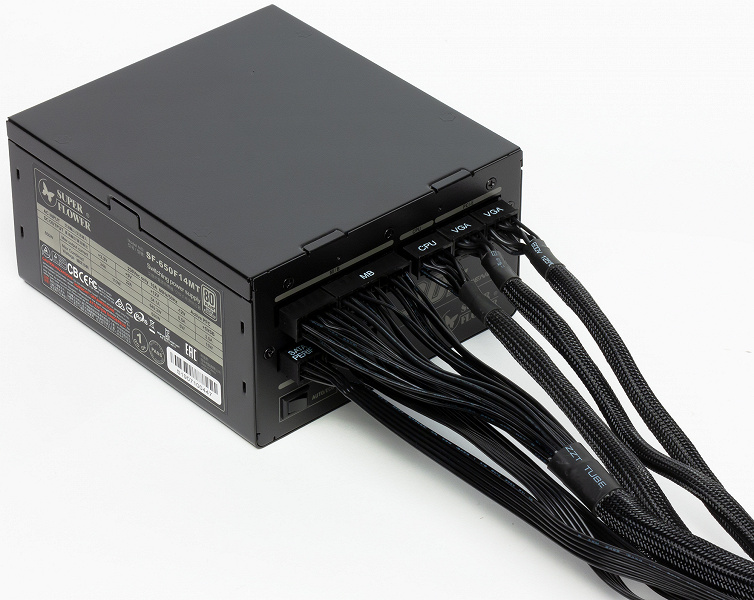
The length of the wires is sufficient for comfortable use in full tower and larger cases with a top-mounted power supply. In cases up to 55 cm high with a bottom-mounted power supply, the length of the wires should also be sufficient: 65 centimeters to the processor power connector. Thus, with most modern cases, there should be no problems. True, taking into account the design of modern cases with advanced systems of hidden wiring, the cord with the processor power connector could well be made longer: say, 70-80 cm, to ensure maximum convenience when assembling the system.
The distribution of connectors over the power cords is not the best, since it will be problematic to fully power several drive installation zones, but in the case of a typical system with a pair of drives, difficulties are unlikely. Straight rather than angled SATA connectors are used, which is much more convenient when connecting drives placed on the plane of the motherboard base and in other similar places. On the positive side, it is worth noting the use of ribbon wires to the connectors, which increases ease of assembly. Unfortunately, ribbon wires are used only for connectors of peripheral devices, and standard nylon-braided cords go to the main connectors, which perfectly collect dust during operation, and are not so convenient during assembly.
Circuitry and cooling
The design of the power supply is in line with modern trends: an active power factor corrector, a synchronous rectifier for the +12VDC channel, and independent switching DC converters for the +3.3VDC and +5VDC lines.

The AKKM high-voltage power elements are installed on a medium-sized radiator along with the input diode assembly, the synchronous rectifier transistors are installed in pairs on small heat sinks, the elements of +3.3VDC and +5VDC channel pulse converters are placed on two daughter printed circuit boards installed vertically (there is no additional heat sink). Elements of the main inverter are installed on individual heat sinks.
It is noticeable that when designing the power supply, measures were taken to improve cooling due to convection, that is, for the mode with the fan stopped.
The power supply is equipped with an active power factor corrector, but is only designed to work in power networks with a nominal voltage of 230 volts, that is, it has a standard, not an extended supply voltage range.

The capacitors in the power supply are predominantly of Japanese origin. In the bulk, these are products under the Nippon Chemi-Con trademark, but there are also a few Capxon capacitors. A large number of polymer capacitors have also been installed.

The power supply is equipped with a 140 mm RL4Z S1402512M fan manufactured by Globe Fan Technology. The fan is based on a plain bearing and has, according to the manufacturer, a rotation speed of 1200 rpm. Two-wire connection via connector.
Measurement of electrical characteristics
Next, we turn to an instrumental study of the electrical characteristics of the power source using a multifunctional stand and other equipment.
The deviation of output voltages from the nominal value is color-coded as follows:
| Colour | Deviation range | Qualitative assessment |
|---|---|---|
| more than 5% | unsatisfactory | |
| +5% | bad | |
| +4% | satisfactorily | |
| +3% | well | |
| +2% | very good | |
| 1% or less | Great | |
| −2% | very good | |
| −3% | well | |
| −4% | satisfactorily | |
| −5% | bad | |
| more than 5% | unsatisfactory |
Working at maximum power
The first stage of testing is the operation of the power supply at maximum power for a long time. Such a test with confidence allows you to verify the performance of the PSU.
The power supply coped with this task without comment.
Cross load characteristic
The next stage of instrumental testing is the construction of a cross-load characteristic (CNC) and its presentation on a quarter-plane, limited by the maximum power on the 3.3 & 5 V bus on the one hand (along the ordinate axis) and the maximum power on the 12 V bus on the other (along the abscissa axis). At each point, the measured voltage value is indicated by a color marker depending on the deviation from the nominal value.
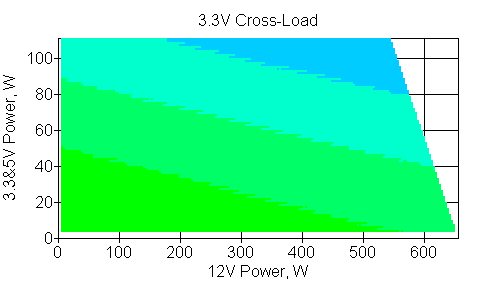
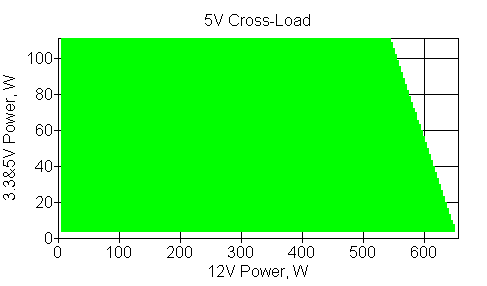
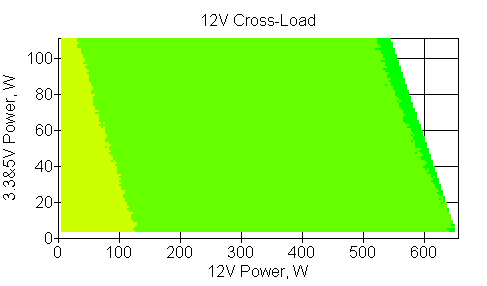
KNH allows us to determine what level of load can be considered acceptable, especially on the + 12VDC channel, for the instance under test. In this case, the deviations of the effective voltage values u200bu200bin the + 12VDC channel are 3% of the nominal value, but since the deviation occurs in the direction of increasing values, this should not cause difficulties.
With a typical power distribution over the channels, deviations from the nominal value do not exceed 3% for the +12VDC channel, 1% for the +5VDC channel, and 2% for the +3.3VDC channel.
This PSU model is well suited for powerful modern systems due to the high practical load capacity of the + 12VDC channel.
load capacity
The following test is designed to determine the maximum power that can be supplied through the appropriate connectors with a normalized voltage deviation of 3 or 5 percent of nominal.

In the case of a video card with a single power connector, the maximum power through the +12VDC channel is at least 150 W with a deviation of 3%.

In the case of a video card with two power connectors, when using one power cord, the maximum power through the +12VDC channel is at least 250 W with a deviation within 3%.

In the case of a video card with two power connectors, when using two power cords, the maximum power through the +12VDC channel is at least 300 W with a deviation within 3%, which allows you to use a very powerful video card.

When loaded through four PCI-E slots, the maximum power per channel + 12VDC is at least 650 W with a deviation of 3%.

When loaded through the processor power connector, the maximum power through the +12VDC channel is at least 250 W with a deviation within 3%. This allows you to use desktop platforms of any level, having a tangible margin.

In the case of the motherboard, the maximum power on the +12VDC channel is over 150 W with a deviation of 3%. Since the board itself consumes within 10 W on this channel, high power may be required to power expansion cards – for example, for video cards without an additional power connector, which usually have a consumption of around 75 W.
Economy and efficiency
When evaluating the efficiency of a computer power supply, there are two ways to go. The first way is to evaluate the computer power supply as a separate electrical energy converter with a further attempt to minimize the resistance of the power transmission line from the PSU to the load (where the current and voltage at the PSU output are measured). To do this, the power supply is usually connected with all available connectors, which puts different power supplies in unequal conditions, since the set of connectors and the number of current-carrying wires are often different even for power supplies of the same power. Thus, although the results are correct for each specific power supply, in real conditions the data obtained is of little use, since in real conditions the power supply is connected to a limited number of connectors, and not all at once. Therefore, it seems logical to determine the efficiency (economics) of a computer power supply not only at fixed power values, including power distribution over channels, but also with a fixed set of connectors for each power value.
Representing the efficiency of a computer power supply in the form of an efficiency value (coefficient of performance) has its own traditions. First of all, efficiency is a coefficient determined by the ratio of the output and input powers of the power supply, that is, the efficiency shows the efficiency of converting electrical energy. For an ordinary user, this parameter will tell almost nothing, except that a higher efficiency seems to indicate a greater efficiency of the PSU and its higher quality. But efficiency has become a great marketing anchor, especially when combined with the 80Plus certification. However, from a practical point of view, efficiency does not have a noticeable effect on the functioning of the system unit: it does not increase performance, does not reduce noise or temperature inside the system unit. This is just a technical parameter, the level of which is mainly determined by the development of the industry at the current time and the cost of the product. For the user, maximizing efficiency results in an increase in the retail price.
On the other hand, sometimes you need to objectively evaluate the efficiency of a computer power supply. By efficiency, we mean the loss of power during the conversion of electricity and its transmission to end consumers. And to evaluate this efficiency is not needed, since you can use not the ratio of two values, but absolute values: power dissipation (the difference between the values u200bu200bof the input and output of the power supply), as well as the energy consumption of the power supply for a certain time (day, month, year etc.) when working with a constant load (power). This makes it easy to see the real difference in power consumption of specific PSU models and, if necessary, calculate the economic benefit of using more expensive power supplies.
Thus, at the output we get a parameter that is understandable to everyone – dissipated power, which is easily converted into kilowatt-hours (kWh), which is recorded by the electric energy meter. Multiplying the obtained value by the cost of a kilowatt-hour, we get the cost of electrical energy, provided that the system unit is operated around the clock throughout the year. Such an option, of course, is purely hypothetical, but it allows you to evaluate the difference between the cost of operating a computer with different power sources for a long period of time and draw conclusions about the economic feasibility of purchasing a particular PSU model. In real conditions, the calculated value can be achieved over a longer period – for example, from 3 years or more. If necessary, everyone can divide the obtained value by the desired coefficient, depending on the number of hours per day during which the system unit is operated in the specified mode in order to obtain electricity consumption for the year.
We decided to single out several typical options in terms of power and correlate them with the number of connectors that correspond to these options, that is, to bring the method of measuring efficiency as close as possible to the conditions that are achieved in a real system unit. At the same time, this will allow you to evaluate the efficiency of different power supplies in completely identical conditions.
| Load through connectors | 12VDC, W | 5VDC, W | 3.3VDC, W | Total power, W |
|---|---|---|---|---|
| main ATX, processor (12 V), SATA | 5 | 5 | 5 | fifteen |
| main ATX, processor (12 V), SATA | 80 | fifteen | 5 | 100 |
| main ATX, processor (12 V), SATA | 180 | fifteen | 5 | 200 |
| main ATX, processor (12V), 6-pin PCIe, SATA | 380 | fifteen | 5 | 400 |
| Main ATX, CPU (12V), 6-pin PCIe (1 cord with 2 connectors), SATA | 480 | fifteen | 5 | 500 |
| main ATX, processor (12 V), 6-pin PCIe (2 cords by 1 connector), SATA | 480 | fifteen | 5 | 500 |
| main ATX, processor (12V), 6-pin PCIe (2 cords of 2 connectors), SATA | 730 | fifteen | 5 | 750 |
The results are as follows:
| Dissipated power, W | 15 W | 100 W | 200 W | 400 W | 500 W (1 cord) |
500 W (2 cords) |
750 W |
|---|---|---|---|---|---|---|---|
| Enhance ENP-1780 | 21.2 | 23.8 | 26.1 | 35.3 | 42.7 | 40.9 | 66.6 |
| Super Flower Leadex II Gold 850W | 12.1 | 14.1 | 19.2 | 34.5 | 45 | 43.7 | 76.7 |
| Super Flower Leadex Silver 650W | 10.9 | 15.1 | 22.8 | 45 | 62.5 | 59.2 | |
| High Power Super GD 850W | 11.3 | 13.1 | 19.2 | 32 | 41.6 | 37.3 | 66.7 |

| Tue | |
| Enhance ENP-1780 | 106.4 |
| Super Flower Leadex II Gold 850W | 79.9 |
| Super Flower Leadex Silver 650W | 93.8 |
| High Power Super GD 850W | 75.6 |
The efficiency of this model is at a quite decent level and is not inferior to solutions with a similar level of certificate.
| Computer energy consumption per year, kWh | 15 W | 100 W | 200 W | 400 W | 500 W (1 cord) |
500 W (2 cords) |
750 W |
|---|---|---|---|---|---|---|---|
| Enhance ENP-1780 | 317 | 1085 | 1981 | 3813 | 4754 | 4738 | 7153 |
| Super Flower Leadex II Gold 850W | 237 | 1000 | 1920 | 3806 | 4774 | 4763 | 7242 |
| Super Flower Leadex Silver 650W | 227 | 1008 | 1952 | 3898 | 4928 | 4899 | |
| High Power Super GD 850W | 230 | 991 | 1920 | 3784 | 4744 | 4707 | 7154 |
The power supply has a low consumption, especially at low load power.
Temperature regime
All major tests were carried out in a constantly rotating fan mode. In this case, the thermal load of the capacitors when operating at maximum power is at a satisfactory level, the thermal load in the rest of the range can be considered low.
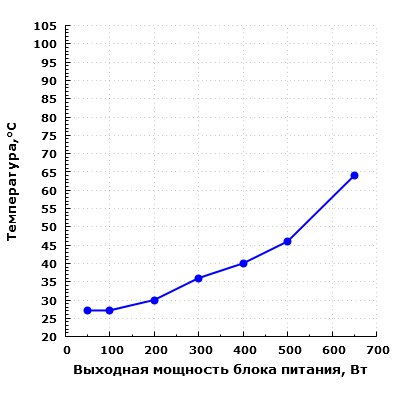
We also studied the functioning of the power supply in the hybrid mode of the cooling system. As a result, it was found that the fan in the power supply turns on only when the threshold temperature on the thermal sensor is reached (about 70 ° C). The fan is also turned off only when the threshold temperature on the temperature sensor is reached (about 42 °C). At a power of 200 W or less, the power supply can work for a long time with the fan stopped. When operating at maximum power, the fan starts 10 minutes after the power supply is turned on. There was no abrupt increase in the noise level when the fan was started.
It should also be taken into account that in the case of operation with the fan stopped, the temperature of the components inside the PSU is highly dependent on the ambient air temperature, and if it is set at 40-45 °C, this will lead to an earlier turning on of the fan.
Acoustic ergonomics
In preparing this material, we used the following method for measuring the noise level of power supplies. The power supply is located on a flat surface with the fan up, above it at a distance of 0.35 meters is placed the measuring microphone of the Octava 110A-Eco sound level meter, which measures the noise level. The power supply is loaded using a special stand that has a silent mode of operation. During the noise level measurement, the power supply is operated at constant power for 20 minutes, after which the noise level is measured.
Such a distance to the measurement object is the closest for the desktop placement of the system unit with the power supply installed. This method allows you to evaluate the noise level of the power supply in harsh environments in terms of a small distance from the noise source to the user. As the distance to the noise source increases and additional barriers appear that have good sound reflecting ability, the noise level at the control point will also decrease, which will lead to an improvement in acoustic ergonomics in general.
This model has a hybrid cooling system, which means that the PSU can operate not only with active, but also with passive cooling. The fan start control is performed depending on the temperature on the temperature sensor. There is also a hardware mode switch for the cooling system, made in the form of a two-position key, which allows the user to independently select the desired mode of operation: normal or hybrid.
When operating in hybrid mode at power up to 200 W inclusive, the operation of the power supply can be considered conditionally silent, since the fan does not rotate for a long time under normal conditions.
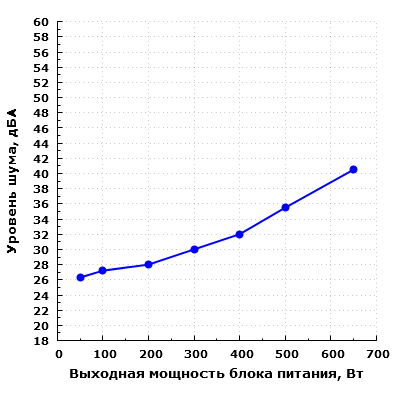
When running with a constantly spinning fan, the power supply noise is at a relatively low level (below average) when operating in the power range up to 300W. Such noise will be hardly noticeable against the background of typical background noise in the room during the daytime, especially when operating this power supply in systems that do not have any sound-noise optimization. In typical home environments, most users rate devices with similar acoustic ergonomics as relatively quiet.
In the power range from 400 to 500 W, noise can be considered average for a residential area during the daytime. This level of noise is quite acceptable when working at a computer.
With a further increase in output power, the noise level increases markedly. At a load of 600 W, the noise of the power supply already exceeds 40 dBA when placed on a desktop, that is, when the power supply is located in the near field in relation to the user. This noise level can be described as quite high.
Thus, in terms of acoustic ergonomics, this model provides comfort with an output power within 500 watts.
We also evaluate the noise level of the power supply electronics, since in some cases it is a source of unwanted overtones. This stage of testing is carried out by determining the difference between the noise level in our laboratory with the power supply on and off. If the obtained value is within 5 dBA, there are no deviations in the acoustic properties of the PSU. With a difference of more than 10 dBA, as a rule, there are certain defects that can be heard from a distance of about half a meter. At this stage of measurements, the sound level meter microphone is located at a distance of about 40 mm from the upper plane of the PSU, since it is very difficult to measure electronic noise at greater distances. The measurement is carried out in two modes: standby mode (STB, or Stand by) and when the PSU is working on the load, but with the fan forcedly stopped.
In standby mode, electronic noise is almost completely absent. In general, the noise of the electronics can be considered relatively low: the excess of background noise was no more than 10 dBA.
Consumer qualities
Consumer qualities of Super Flower Leadex Silver 650W are at a good level. The load capacity of the +12VDC channel of this power supply is high, which allows it to be used in fairly powerful systems with one or two video cards. Acoustic ergonomics here are not the most outstanding, but at low and medium loads, the noise is low, but at 650 W it becomes not very pleasant. But in real conditions, components with such consumption will themselves emit significant noise. The length of the PSU wires is sufficient for modern mid-budget cases, but there are not too many connectors for peripheral devices, and they are not very well located.
Results
Super Flower Leadex Silver 650W is a solid mid-ranger, albeit with some nuances. In particular, I would like the fan to be on a bearing with a longer service life, and what prevented the installation of all 100% capacitors from Japanese companies is also not entirely clear. On the other hand, this PSU represents the second “from the bottom” series of Super Flower power supplies, so it should at least be inferior to its older brothers in some way.




